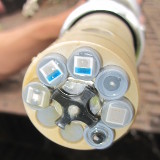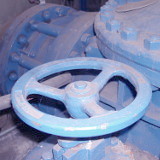Our mission
Our mission is the development, implementation and operation of smarter, resilient and autonomous (think of self-healing) water supply systems by combining research and engineering expertise.
Our main research areas include:
- Adaptive Water Distribution Networks with Dynamically Reconfigurable Topology. This research combines the development of sensing and control technologies with advances in hydraulic modelling, optimal and robust control, estimation, model identification, and optimisation for large-scale hydraulic systems.
- Towards Steady-State Operation of Water Supply Systems. We monitor, analyse and investigate the impact of the dynamic hydraulic conditions (pressure transients and hydraulic instabilities) on assets failures, water quality deterioration and uncertainty in hydraulic models.
Increasing population, water demand, and ageing infrastructure combined with increasing regulatory and financial pressure are forcing the UK water utilities to actively seek novel and integrated operational strategies for managing leakage, demand, and energy efficiency in order to deliver a high quality and cost effective supply to customers. UK water companies operate some of the oldest water supply systems in the world. For example, nearly 50% of the pipes in London are over 100 years old, 30% of the pipes are over 150 years old, and many pumping stations are over 40 years old. This presents unique challenges to meet increasing population demand with limited water and financial resources. Many cities in the world are starting to face similar problems. By successfully applying the technologies and analytics developed by InfraSense Labs to the ageing water supply networks in the UK we significantly improve leakage, demand, energy and incident management. This ability and opportunities are illustrated in our project portfolio.
Research Projects
Dynamic Pressure and Zone Control for Optimal Management of Water Supply Systems (DMA 2.0) with Bristol Water & Cla-Val

This research project investigates the development and implementation of techniques for near real time (nRT) adaptive reconfiguration of water supply networks to improve resilience, leakage and incident management. The implementation of District Metered Areas (DMAs) over the last twenty years has greatly assisted water utilities in reducing leakage. DMAs segregate water networks into small areas, the flow in and out of each area is monitored and thresholds are derived from the minimum night flow to trigger the leak localisation. A major drawback of the DMA approach (or as we would like to refer to as DMA v1.0) is the reduced redundancy in network connectivity which has a severe impact on network resilience, incident management and water quality deterioration. The approach we have pioneered for adaptively reconfigurable networks (DMA v2.0) integrates the benefits of DMAs for managing leakage with the advantages of large-scale looped networks for increased redundancy in connectivity, reliability and resilience. Self-powered multi-function network controllers (developed in collaboration with Cla-Val) have been designed and integrated with novel telemetry tools for high-speed time-synchronised monitoring of the dynamic hydraulic conditions (InfraSense TS technologies). A computationally efficient and robust optimization method based on sequential convex programming is developed and applied for the dynamic topology reconfiguration and pressure control of water distribution networks. An extensive experimental programme is being carried out using an operational network to evaluate the implementation, benefits and scalability of the proposed method. The work is extensively supported by Cla-Val and Bristol Water.
For further information:
NEC–Imperial Smart Water Systems Project with NEC & Bristol Water

This project further advances our research activities in the area of adaptively reconfigurable water supply networks by encompassing topics in computationally efficient and robust modelling, model predictive control and optimisation for large-scale hydraulic systems. One of our objectives is to study robust hydraulic and topology control of water distribution systems to meet multiple performance objectives while satisfying physical and economic constraints. Efficient and highly scalable optimisation tools and linear solvers are being tailored for water distribution system simulation and control. In addition to the development of operational tools for optimised near real time reconfiguration of District Metered Areas (DMAs) topologies, techniques for the automatic detection and localization of faults for incident management are investigated. Within this project, the InfraSense Labs has also setup a unique industrial-academic partnership to advance these novel and challenging concepts and technologies (e.g. SCADA systems, Big Data analytics and model predictive control) to deliver the next generation of smarter, resilient and autonomous (self-healing) water supply networks.
A Smart Water Networks Demonstrator (SWND) which is part of an operational network in a dense urban setting has been built and utilised to evaluate the developed sensing, data, analytical and control technologies and assess the operational benefits.
For further information: NEC-Smart Water System Project
Dynamic Zone Control for Optimal Water Quality Management in Water Distribution Systems with Bristol Water

This project investigates and develops proactive management strategies to reduce the risk of water quality failures in supply networks. The research combines improved understanding of the mechanisms influencing the water quality deterioration in distribution systems with the novel concepts we have pioneered for adaptively reconfigurable water supply networks. For example, one key objective is to investigate the impact of District Metered Areas (DMAs) on water quality deterioration and chlorine decay due to changes in network connectivity and the hydrodynamics of a system. This research will help water companies to improve the microbiological and aesthetic quality of water in a proactive manner while reducing their operational costs (e.g. reduce flushing and also chemical dosing). The work is supported by Bristol Water.
Towards Steady-State Operation of Water Supply Systems with Severn Trent Water, Essex & Suffolk Water, & Bristol Water

The dynamic hydraulic behaviour has a significant impact upon the performance of water distribution networks, including increased cyclic stresses, fatigue corrosion, discolouration, and water quality issues. Due to the lack of operational high resolution pressure data, limited information on failure mechanisms and the relative complexity of computer analysis tools, various simplifications were made when studying the dynamic hydraulic phenomena. Over the last few years, advances in modelling as well as sensing and data management tools and technologies developed by the InfraSense Labs have allowed a more detailed investigation of the occurrence and impact of these phenomena. This research utilises the InfraSense TS technology in order to enable a detailed investigation and understanding of dynamic hydraulic conditions in operational systems, analyse their root causes, and assess their impact upon the system performance and deterioration processes.
The research is extensively supported by Severn Trent Water, Essex and Suffolk Water and Bristol Water.
InfraSense TS Technologies: Monitoring and Analysing the Dynamic Hydraulic Conditions in Water Supply Systems with Severn Trent Water, Essex & Suffolk Water, & Bristol Water

Our patent pending InfraSense TS (Transient Signals) technology allows us to continuously measure pressure (128S/s, time synchronization of 5ms) and perform signal processing to determine the occurrence, magnitude and sources of pressure transients and hydraulic instabilities. Acquired raw and processed data, and classified events are stored using the InfraSense TS over a period of six months in a rotating memory buffer thus allowing the execution of retrospective queries for snippets of high-frequency data (Stoianov and Hoskins, 2012, United Kingdom Patent Application No: 1221644.6). The cloud-based InfraSense TS data management system implements our advanced research in embedded stream processing and complex event detection across spatially distributed sensors which enables remote querying and analysis of large volumes of continuously acquired high-speed time-synchronised data. The InfraSense TS has been used to carry out the world’s most extensive investigation of the occurrence of hydraulic transients. One hundred TS devices are currently being utilised by Bristol Water, Severn Trent Water and Essex and Suffolk Water in their quest to reduce bursts and discoloration events, diagnose hydraulic instabilities caused by pressure reducing and control valves, and implement safe pump scheduling. The InfraSense TS technology gathers in excess of 60GB of pressure data per month which is approximately 3 orders of magnitude more data than an average size UK water company gathers over the same time period.
The research is extensively supported by Severn Trent Water, Essex and Suffolk Water and Bristol Water.
Analytical and Experimental Investigation of Monochloramine Decay in Water Supply Systems Under Unsteady-State Hydraulic Conditions with Thames Water Utilities Ltd

This project investigates analytically and experimentally the impact of the dynamic hydraulic conditions on the kinetics of monochloramine decay in water supply systems. Knowledge of the impact of quasi-unsteady and unsteady state flows on disinfectant decay and water quality deterioration is very limited. In order to advance this knowledge, we utilise our InfraSense technologies for continuous high-resolution monitoring which enable a scale adaptive modelling of the operational hydraulic conditions including steady, quasi-unsteady and unsteady state flows. We coupled the InfraSense TS with multi-parameter water quality sensors for in-pipe reagent-free water quality monitoring and carried out a pioneering experimental and analytical investigation in a water transmission main. The results were used for extending the proposed scale-adaptive simulation framework to model monochloramine decay under a wide range of dynamic hydraulic conditions. The quasi-unsteady state flow conditions are approximated using extended period simulation with a short time step, while a 1-D transient water quality model with a shear stress dependent decay coefficient was developed to simulate the monochloramine transport under unsteady-state flow conditions. The unsteady model couples the mass transport equation with a hydraulic transient solver. Within the proposed scale-adaptive simulation framework, we define steady and unsteady decay coefficients which depend upon the absolute value of shear stress and the rate of change of shear stress for quasi-unsteady and unsteady-state flows. The results demonstrate that the dynamic hydraulic conditions have a significant impact on the water quality deterioration in water supply systems. Our instrumentation and sensing technologies provide unique understanding of the unsteady flow dynamics and enable the implementation of hybrid simulation frameworks capable of modelling both the quasi-unsteady and unsteady-state hydraulic and water quality conditions. The research programme also investigates the dynamic wall-shear stress induced detachment of viscoelastic biofilms and resuspension of sediments.
For further information:
This research is supported by Thames Water Utilities Ltd.